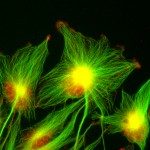Lien vers Pubmed [PMID] – 16211083
EMBO Rep. 2005 Dec;6(12):1201-7
Tracheal cytotoxin (TCT) was originally described as the minimal effector that was able to reproduce the cytotoxic response of Bordetella pertussis on ciliated epithelial cells. This molecule triggers pleiotropic effects such as immune stimulation or slow-wave sleep modulation. Further characterization identified TCT as a specific diaminopimelic acid (DAP)-containing muropeptide, GlcNAc-(anhydro)MurNAc-L-Ala-D-Glu-mesoDAP-D-Ala. Here, we show that the biological activity of TCT depends on Nod1, an intracellular sensor of bacterial peptidoglycan. However, Nod1-dependent detection of TCT was found to be host specific, as human Nod1 (hNod1) poorly detected TCT, whereas mouse Nod1 (mNod1) did so efficiently. More generally, hNod1 required a tripeptide (L-Ala-D-Glu-mesoDAP) for efficient sensing of peptidoglycan, whereas mNod1 detected a tetrapeptide structure (L-Ala-D-Glu-mesoDAP-D-Ala). In murine macrophages, TCT stimulated cytokine secretion and NO production through Nod1. Finally, in vivo, injection of the tetrapeptide structure in mice triggered a transient yet strong release of cytokines into the bloodstream and the maturation of macrophages, in a Nod1-dependent manner. This study thereby identifies Nod1 as the long sought after sensor of TCT in mammals.

